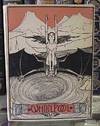
Frank Lloyd Wright's Glass Designs
by Lind, Carla
- Used
- very good
- Hardcover
- Condition
- Very good/Very good
- ISBN 10
- 0876544685
- ISBN 13
- 9780876544686
- Seller
-
Silver Spring, Maryland, United States
Payment Methods Accepted
About This Item
San Francisco: Pomegranate ArtBooks, An Archetype Press Book, 1995. Fourth printing [stated]. Hardcover. Very good/Very good. Format is approximately 5.25 inches by 5.25 inches. [1], 57 pages. Illustrated endpapers. Illustrations (color). Further Reading. This work looks at the innovative ways Wright used glass in windows, skylights, and decorative designs Carla Lind worked to preserve Wright's building for more tan two decades. She directed the Frank Lloyd Wright Home and Studio and the Frank Lloyd Wright Building Conservancy as well as the restoration of Wright's May house in Grand Rapids, Michigan. Frank Lloyd Wright (June 8, 1867 - April 9, 1959) was an American architect, designer, writer, and educator. He designed more than 1,000 structures over a creative period of 70 years. Wright played a key role in the architectural movements of the twentieth century, influencing architects worldwide through his works and hundreds of apprentices in his Taliesin Fellowship. Wright believed in designing in harmony with humanity and the environment, a philosophy he called organic architecture. This philosophy was exemplified in Fallingwater (1935), which has been called "the best all-time work of American architecture." Contents include Introduction, Features, Art Glass, Sullivanesque Forms, Geometric Designs, Nature Patterns, Lighting, Applied Glass, Divided Glass, Innovations, Luxfer Prism Glass, Glass in Concrete Blocks, Glass in Wooden Panels, Invisible Joints, Tubular Glass, Window Walls, and Further Reading. No other architect or designer of the modern era transformed the use of leaded glass in architecture as Frank Lloyd Wright. Creating ribbons of uninterrupted glass casement windows and doors in his Prairie style buildings, Wright conceived his windows as an integral part of his organic design. Known for their extensive use of clear glass with touches of color, the glass designs are all geometric abstractions unique to each building for which they were created. Wright called them "light screens." The sources for Wright's glass designs range from the Froebel gifts of his childhood to Louis Sullivan's flat ornamentation, to the designs of the Vienna Secession. But it was Japan that dominated Wright's early aesthetic - the flat areas of color enclosed within black lines in the Japanese prints that he admired and the way in which the sliding shoji screens of indigenous Japanese architecture unite exterior and interior space. Wright stated, "I was working away at the wall as a wall and bringing it towards the function of a screen, a means of opening up space." Wright's light screens illuminated his interiors with natural light, touched by the autumnal dashes of his color palette and animated by his exquisite visual geometries. Wright's buildings follow the geometric principles he imposed on each project, and his glass designs also express the geometry that unites the building. Between 1885 and 1923, when he stopped using leaded glass, Frank Lloyd Wright designed 163 buildings - of which 97 were constructed - that included leaded glass of his own design. Several of Frank Lloyd Wright's structures, such as the landmark Robie House in Chicago and the Unity Temple in Oak Park, incorporated stained glass. Wright's design goal was to achieve balance between the natural and manmade environments. He believed that using natural light and colors would contribute to this harmony. His use of stained glass was not only a stylistic preference but also a means of connecting the natural world outside to his interior spaces. He was especially fascinated by how sunlight filtered through the glass, producing a dance of light and shadow that added to the overall ambiance.
Reviews
(Log in or Create an Account first!)
Details
- Bookseller
- Ground Zero Books
(US)
- Bookseller's Inventory #
- 86210
- Title
- Frank Lloyd Wright's Glass Designs
- Author
- Lind, Carla
- Format/Binding
- Hardcover
- Book Condition
- Used - Very good
- Jacket Condition
- Very good
- Quantity Available
- 1
- Edition
- Fourth printing [stated]
- ISBN 10
- 0876544685
- ISBN 13
- 9780876544686
- Publisher
- Pomegranate ArtBooks, An Archetype Press Book
- Place of Publication
- San Francisco
- Date Published
- 1995
- Keywords
- Frank Lloyd Wright, Architect, Interior Design, Art Glass, Geometric Designs, Nature Patterns, Lighting, Applied Glass, Divided Glass, Innovations, Luxfer Prism Glass, Glass in Concrete Blocks, Glass in Wooden Panels, Invisible Joints, Tubular Glass
Terms of Sale
Ground Zero Books
Books are offered subject to prior sale. Satisfaction guaranteed. If you notify us within 7 days that you are not satisfied with your purchase, we will refund your purchase price when you return the item in the condition in which it was sold.
About the Seller
Ground Zero Books
Biblio member since 2005
Silver Spring, Maryland
About Ground Zero Books
Founded and operated by trained historians, Ground Zero Books, Ltd., has for over 30 years served scholars, collectors, universities, and all who are interested in military and political history.
Much of our diverse stock is not yet listed on line. If you can't locate the book or other item that you want, please contact us. We may well have it in stock. We welcome your want lists, and encourage you to send them to us.
Much of our diverse stock is not yet listed on line. If you can't locate the book or other item that you want, please contact us. We may well have it in stock. We welcome your want lists, and encourage you to send them to us.
Glossary
Some terminology that may be used in this description includes:

